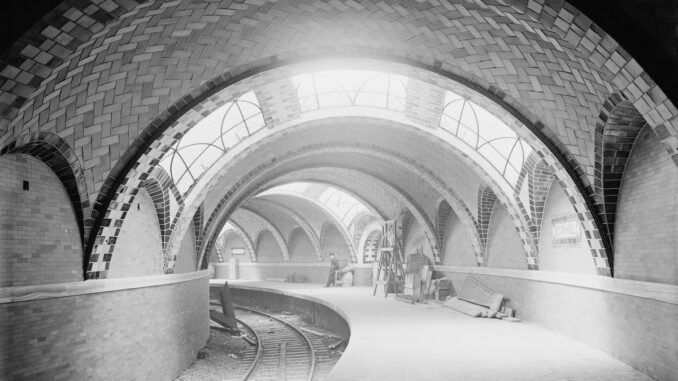
On Oct. 27, 1904, New York City changed forever when its first subway opened from City Hall to 145th Street. The fare was a nickel.
More than 150,000 people rode on the first day, packing marble-tiled stations and marveling at a 25-minute run uptown. Designed to ease congestion and link neighborhoods, the line quickly transformed how New Yorkers lived and worked.
The opening followed decades of debate over subways versus elevated rail and competing routes. For example, Alfred Beach proposed building a pneumatic tube 30 years before the subway opened.
In 1900, August Belmont Jr. and John B. McDonald won the contract to build the subway after outbidding Andrew Onderdonk. Belmont founded the Interborough Rapid Transit Company (IRT) on May 6, 1902. The subway opened on Oct. 27, 1904, to generally positive reviews.
“The public must not judge the Rapid Transit system by the operation of the first few days,” General Manager Frank Hedley said, according to a report in the New York Herald. “Never before has one complete section of a railroad system been opened on the tick of the clock, and there are likely to be some slight delays.
“The system, however, will be improved in the matter of operation from day to day until it is brought as nearly to perfection as possible,” Hedley added. “All we ask is that the public suspend its judgment for a short time.”
The early IRT featured a single trunk south of 96th Street under Broadway, 42nd Street, Park Avenue and Lafayette Street, with a southern branch to Brooklyn. Between Brooklyn Bridge–City Hall and 96th Street, four tracks enabled local and express service, while three branches extended into Upper Manhattan and the Bronx.
In 1903, the IRT leased the Manhattan Railway Company, which ran four elevated lines, giving the company a rapid-transit monopoly in Manhattan. Some coordinated services followed, though the Manhattan “els” were later dismantled.
On June 12, 1940, the city bought the IRT along with the BMT and IND, creating today’s unified subway. Former IRT routes — the numbered lines — now make up the A Division of the New York City Subway.
“Every step in the direction of interborough communication benefits not only the borough immediately affected, but benefits the city as a whole,” Mayor George B. McClellan Jr. said, according to the New-York Tribune. “The constant shifting of population among the boroughs, acting and reacting upon them, results in the increase of the population of all.
“We have met here to-day for the purpose of turning over a page in the history of New-York; for the purpose of marking the advent of a new epoch in her development,” the mayor added. “If this new underground railroad which we are about to open proves as popular and as successful as I confidently expect it to be, it will be only the first of many more which must ultimately result in giving us an almost perfect system of interborough communication. When that day arrives borough boundaries will be remembered only for administrative purposes, and New-Yorkers, forgetting from what part of the city they came and only conscious of the fact that they are the sons of the mightiest metropolis the world has ever seen, will be actuated by a common hope and united in a common destiny.”

